NCERT Exemplar Solutions Class 10 Science Chapter 15 – Free PDF Download
The NCERT Exemplar Class 10 Science Chapter 15 Our Environment presents you with answers and explanations to questions provided in the NCERT Exemplar book. Students are recommended to go through the Exemplar provided here to solve questions and score well for the board exam. NCERT Exemplar is a very important study material as similar kinds of questions are asked in the board exam. Solving all these questions will help you gain confidence and eliminate the exam fear in you.
In this chapter, students will be studying how the different components in the environment interact with each other and how people and their actions impact the environment. Students will understand the various types of waste that we dispose of in the environment and their impact on the ecosystem. However, there are some important concepts that students should study and remember. NCERT Exemplars Solutions provide answers to 21 MCQs, 9 short answer and 8 long answer questions provided in the NCERT Exemplar book. Students can access Class 10 Science NCERT Exemplar Chapter 15 below.
Download the PDF of NCERT Exemplar Solutions for Class 10 Science Chapter 15 – Our Environment
Access Answers to the NCERT Exemplar Class 10 Science Chapter 15 – Our Environment
Multiple Choice Questions
1. Which one of the following is an artificial ecosystem?
(a) Pond
(b) Crop field
(c) Lake
(d) Forest
Soln:
The answer is (b) Crop field
Explanation:
Crop field is a man-made ecosystem.
2. In a food chain, the third trophic level is always occupied by
(a) carnivores
(b) herbivores
(c) decomposers
(d) producers
Soln:
The answer is (a) carnivores
Explanation:
First trophic level are producers, second trophic level are herbivores, the third trophic level is occupied by carnivores.
3. An ecosystem includes
(a) all living organisms
(b) non-living objects
(c) both living organisms and non-living objects
(d) sometimes living organisms and sometimes non-living objects
Soln:
The answer is (c) both living organisms and non-living objects
Explanation:
An ecosystem is a complex of living and nonliving organisms and their interactions.
4. In the given food chain, suppose the amount of energy at the fourth trophic level is 5 kJ, what will be the energy available at the producer level?
Grass → Grasshopper → Frog → Snake → Hawk
(a) 5 k J
(b) 50 k J
(c) 500 k J
(d) 5000 k J
Soln:
The answer is (d) 5000 k J
Explanation:
Available energy level at a particular trophic level is 10 times the energy level at next tropic level. Hence, energy at a third level trophic level is 50kj. Second level trophic has 500 KJ energy and 1st level trophic level (Producer) has energy of 5000 KJ.
5. Accumulation of non-biodegradable pesticides in the food chain in increasing amount at each higher trophic level is known as
(a) eutrophication
(b) pollution
(c) biomagnification
(d) accumulation
Soln:
The answer is (c) biomagnification
Explanation:
- Eutrophication is richness of nutrient beyond optimum level. Eutrophication occurs due to runoff from land.
- Introduction of an undesired substance into the environment. Pollution leads to harmful effects on living organisms.
6. Depletion of ozone is mainly due to
(a) chlorofluorocarbon compounds
(b) carbon monoxide
(c) methane
(d) pesticides
Soln:
The answer is (a) chlorofluorocarbon compounds
7. Organisms which synthesise carbohydrates from inorganic compounds using radiant energy are called
(a) decomposers
(b) producers
(c) herbivores
(d) carnivores
Soln:
The answer is (b) producers
Explanation:
Producers use solar energy to synthesize food from water and carbon-di-oxide. Plants and few micro-organisms are the producers.
Organisms that decompose organic material are called decomposers.
Herbivores are the organisms that feed on plant and its products.
Carnivore are the ones which feed on other organisms.
8. In an ecosystem, the 10% of energy available for transfer from one trophic level to the next is in the form of
(a) heat energy
(b) light energy
(c) chemical energy
(d) mechanical energy
Soln:
The answer is (c) chemical energy
Explanation:
Energy is available for transfer from one trophic level to the next in the form of food. Food is a chemical form of energy.
9. Organisms of a higher trophic level which feed on several types of organisms belonging to a lower trophic level constitute the
(a) food web
(b) ecological pyramid
(c) ecosystem
(d) food chain
Soln:
The answer is (a) food web
Explanation:
A series of organisms through which food energy flows in an ecosystem is called a food chain. An ecosystem consists of all the living beings of an area and non-living components of their environment. The graphic summary of the trophic structure and energy transfer in an ecosystem is called ecological pyramids. Organisms of a higher trophic level which feed on several types of organisms belonging to a lower trophic level constitute the food web.
10. Flow of energy in an ecosystem is always
(a) unidirectional
(b) bidirectional
(c) multidirectional
(d) no specific direction
Soln:
The answer is (a) unidirectional
Explanation:
The flow of energy is from prey to predator and it cannot be in the reverse direction. Hence the flow of energy is uni-directional.
11. Excessive exposure of humans to U V-rays results in
(i) damage to the immune system
(ii) damage to lungs
(iii) skin cancer
(iv) peptic ulcers
(a) (i) and (ii)
(b) (ii) and (iv)
(c) (i) and (iii)
(d) (iii) and (iv)
Soln:
The answer is (c) (i) and (iii)
Explanation:
UV rays affect upper surface of our body. UV rays lead to skin cancer and effect on skin will affect our immune system as skin is considered as the primary level of the immune barrier.
12. In the following groups of materials, which group (s) contains only non-biodegradable items?
(i) Wood, paper, leather
(ii) Polythene, detergent, PVC
(iii) Plastic, detergent, grass
(iv) Plastic, bakelite, DDT
(a) (iii)
(b) (iv)
(c) (i) and (iii)
(d) (ii) and (iv)
Soln:
The answer is (d) (ii) and (iv)
Explanation:
Group i) has wood and leather which are biodegradable. Group iii) has grass which is biodegradable hence the answer is d) (ii) and (iv)
13. Which of the following limits the number of trophic levels in a food chain?
(a) Decrease in energy at higher trophic levels
(b) Sufficient food supply
(c) Polluted air
(d) Water
Soln:
The answer is (a) Decrease in energy at higher trophic levels
Explanation:
Available energy level at a particular trophic level is 10 times the energy level at next tropic level. When we reach the fourth trophic level; a minute portion of energy from producer is available.
14. Which of the statement is incorrect?
(a) All green plants and blue-green algae are producers
(b) Green plants get their food from organic compounds
(c) Producers prepare their own food from inorganic compounds
(d) Plants convert solar energy into chemical energy
Soln:
The answer is (b) Green plants get their food from organic compounds
Explanation:
Green plants produce their food by harnessing solar energy. Solar energy is used to prepare carbohydrate with the help of CO2 and water which are inorganic substances.
15. Which group of organisms are not constituents of a food chain?
(i) Grass, lion, rabbit, wolf
(ii) Plankton, man, fish, grasshopper
(iii) Wolf, grass, snake, tiger
(iv) Frog, snake, eagle, grass, grasshopper
(a) (i) and (iii)
(b) (iii) and (iv)
(c) (ii) and (iii)
(d) (i) and (iv)
Soln:
The answer is (c) (ii) and (iii)
Explanation:
In option ii) plankton does not eat grass. In option iii) none of them eat grass hence option c) is the right answer.
16. The percentage of solar radiation absorbed by all the green plants for the process of photosynthesis is about
(a) 1 %
(b) 5 %
(c) 8 %
(d) 10 %
Soln:
The answer is (a) 1 %
Explanation:
Green plants utilize 1% of the radiation absorbed by leaf and use it for photosynthesis.
17. In the given Figure 15.1 the various trophic levels are shown in a pyramid. At which trophic level is maximum energy available?
(a) T4
(b) T2
(c) T1
(d) T3

Soln:
Answer is (c) T1
Maximum energy is available for producers. Only 10% of the energy is consumed by an organism at the next level. Hence T1>T2>T3>T4
18. What will happen if deer is missing in the food chain given below? Grass → Deer → Tiger
(a) The population of tiger increases
(b) The population of grass decreases
(c) Tiger will start eating grass
(d) The population of tiger decreases and the population of grass increases
Soln:
The answer is (d) The population of tiger decreases and the population of grass increases.
Explanation:
Lack of predators will increase the population of grass. Population of tiger will reduce due to lack of food.
19. The decomposers in an ecosystem
(a) convert inorganic material, to simpler forms
(b) convert organic material to inorganic forms
(c) convert inorganic materials into organic compounds
(d) do not breakdown organic compounds
Soln:
The answer is (b) convert organic material to inorganic forms
20. If a grasshopper is eaten by a frog, then the energy transfer will be from
(a) producer to decomposer
(b) producer to primary consumer
(c) primary consumer to secondary consumer
(d) secondary consumer to primary consumer
Soln:
Answer is (c) primary consumer to secondary consumer
Explanation:
Grasshopper is a primary consumer because it feeds on grass. If grasshopper is getting eaten by a frog. Frog will be the secondary consumer.
21. Disposable plastic plates should not be used because
(a) they are made of materials with lightweight
(b) they are made of toxic materials
(c) they are made of biodegradable materials
(d) they are made of non-biodegradable materials
Soln:
The answer is (d) they are made of non-biodegradable materials
Explanation:
Plastics are non-biodegradable hence they start accumulating in nature harming living organisms.
Short Answer Questions
22. Why is improper disposal of waste a curse to the environment?
Soln:
Wastes pollute our environment, air, soil and water, and cause harmful effects on all living organisms.
23. Write the common food chain of a pond ecosystem.
Soln:
Phyto planktons
↓
Small aquatic animals larvae, shrimps, Insects
↓
Fish
↓
Bird
24. What are the advantages of cloth bags over plastic bags during shopping?
Soln:
Advantages of cloth bags over plastic bags during shopping are as follows
They can carry more weight than plastic bags
They are bio-degradable
They can be reused.
They do not cause environmental pollution.
25. Why are crop fields known as artificial ecosystems?
Soln:
Crops field are known as artificial ecosystems because they are manmade where certain biotic and abiotic components are manipulated.
26. Differentiate between biodegradable and non-biodegradable substances. Cite examples.
Soln:
Substances which can be broken into pieces by the biological process are known as biodegradable substance.
Substances which cannot be broken into pieces by the biological process are known as non-biodegradable substance.
27. Suggest one word for each of the following statements/ definitions
(a) The physical and biological world where we live in
(b) Each level of the food chain where the transfer of energy takes place
(c) The physical factors like temperature, rainfall, wind and soil of an ecosystem
(d) Organisms which depend on the producers either directly or indirectly for food
Soln:
- Environment
- Trophic level
- Abiotic factors
- Consumers or heterotrophs
28. Explain the role of decomposers in the environment?
Soln:
Decomposers breakdown dead and decaying living matter and helps in the nutrient recycling. This will clean the environment by removing dead material.
29. Select the mismatched pair in the following and correct it.
(a) Biomagnification — Accumulation of chemicals at the successive trophic levels of a food chain
(b) Ecosystem — Biotic components of environment
(c) Aquarium — A man-made ecosystem
(d) Parasites — Organisms which obtain food from other living organisms
Soln:
(a) Biomagnification — Accumulation of chemicals at the successive trophic levels of a food chain
(b) Ecosystem — Biotic components of environment
(c) Aquarium — A man-made ecosystem
(d) Parasites — Organisms which obtain food from other living organisms
Soln:
The answer is (b) Ecosystem — Biotic components of environment
Both biotic and abiotic components of the environment constitute an ecosystem.
30. We do not clean ponds or lakes, but an aquarium needs to be cleaned. Why?
Soln:
An aquarium is an artificial ecosystem which is incomplete ecosystem when compared to pond or lake which is a natural and complete ecosystem.
Long Answer Questions
31. Indicate the flow of energy in an ecosystem. Why is it unidirectional? Justify.
Soln:
Flow of energy in an ecosystem is as follows.
The green plants in a terrestrial ecosystem capture about 1% of the energy of sunlight that falls on their leaves and convert it into food energy.
When green plants are eaten by primary consumers, a great deal of energy is lost as heat to the environment, some amount goes into digestion and in doing work and the rest goes towards growth and reproduction. An average of 10% of the food eaten is turned into its own body and made available for the next level of consumers.
Therefore, 10% can be taken as the average value for the amount of organic matter that is present at each step and reaches the next level of consumers.
Since so little energy is available for the next level of consumers, food chains generally consist of only three or four steps. The loss of energy at each step is so great that very little usable energy remains after four trophic levels.
There are generally a greater number of individuals at the lower trophic levels of an ecosystem, the greatest number is of the producers.
The length and complexity of food chains vary greatly. Each organism is generally eaten by two or more other kinds of organisms which in turn are eaten by several other organisms. So instead of a straight line food chain, the relationship can be shown as a series of branching lines called a food web.

The flow of energy is unidirectional because the energy that is captured by the autotrophs does not revert to the solar input and the energy which passes to the herbivores does not come back to autotrophs. As it moves progressively through the various trophic levels it is no longer available to the previous level. Secondly, the energy available at each trophic level gets diminished progressively due to the loss of energy at each level.
32. What are decomposers? What will be the consequence of their absence in an ecosystem?
Soln:
Microorganisms, comprising bacteria and fungi, break-down the dead remains and waste products of organisms. These microorganisms are the decomposers as they break-down the complex organic substances into simple inorganic substances that go into the soil and are used up once more by the plants.
If decomposers are absent in the ecosystem recycling of material in the biosphere will not take place which would lead to the accumulation of dead plants and animals in the environment. Additionally, the environment would be finally devoid of all its resources which are needed to maintain and sustain life.
33. Suggest any four activities in daily life which are eco-friendly
Soln:
Activities in daily life which are eco-friendly are as follows
- Using of bicycles and electrical bikes instead of vehicles run by fossil fuels.
- Avoid using plastic bags, instead we can use bags made of clothes and papers.
- Plant trees in our surroundings.
- Stop usage of old items and recycle them.
34. Give two differences between food chain and food web.
Soln:
| Food Chain | Food web |
| The food chain is the straight and single pathway for the flow of energy in an ecosystem, through different species of organisms. | Food web is defined as the convoluted or complicated pathway of an ecosystem consist of numerous food chains of the different trophic level, through which the energy flow. |
| Food chain is a hypothetical situation | Food web is a real-life situation. |
| Members of higher trophic level feed on a single type of organism of lower trophic level | Members of higher trophic level can feed upon organisms of the lower trophic levels of another food chain. |
35. Name the wastes which are generated in your house daily. What measures would you take for their disposal?
Soln:
Wastes generated in our house daily are as follows
(a) Kitchen wastes
(b) Paper wastes like newspapers, bags, envelopes
(c) Plastic bags
(d) Vegetable/fruit peels/rind Measures for disposal
Measures to take to dispose of house waste are
(a) Segregation of biodegradable and non-biodegradable wastes.
(b) Safe disposal of plastic bags.
(c) Vegetable/fruit peels can be placed near trees/plants, which on decomposition will enrich the soil with nutrients.
(d) Give paper wastes for recycling.
(e) Prepare a compost pit for kitchen wastes.
36. Suggest suitable mechanism (s) for waste management in fertiliser industries.
Soln:
To manage waste in the fertiliser industry following steps must be taken:
• For control of gaseous pollutants combustion equipments are used which can be oxidised. The pollutants are exposed to a high temperature in the process. Air pollutants, such as certain gases and vapour and inflammable compounds are controlled through the use’ of adsorption equipments. Adsorption is a surface phenomenon, and it needs the presence of a large solid surface area. This process removes toxic and odoriferous compounds are efficiently.
Three options available for controlling the effluents are:
• Control can take place at the point of generation within the factory.
• Wastewater can be pre-treated for discharge to municipal treatment systems.
• Wastewater can be treated completely at the factory and either reused or discharged directly for receiving water.
37. What are the by-products of fertiliser industries? How do they affect the environment?
Soln:
The most common byproduct of fertilizer industries are oxides of nitrogen and sulphur. They pass into the atmosphere and spread to all nearby places. The gases have a corrosive effect on several items besides being harmful to living beings. They also give rise to acid rain. Acid rain is highly destructive to forests, crops and aquatic biota.
Oxides of Nitrogen and Sulphur are the most common by-product of fertilizer industries. These oxides pass into the atmosphere and spread to all nearby places. Sulphur and nitrogen oxides have a corrosive effect on several items besides being harmful to living beings. Sulphur oxides lead to acid rain which causes harms to forests, crops and aquatic biota.
38. Explain some harmful effects of agricultural practices on the environment.
Soln:
Following are the harmful effects of agricultural practices on the environment
Soil degradation Extensive cropping causes loss of soil fertility. Also, over time it can lead to soil erosion and finally to desertification.
Pollution
Use of synthetic fertilisers and pesticides leads to soil, water and air pollution. •
Water shortage
Excess use of groundwater for agriculture lowers the water level. This results in acute water shortage at many places.
Bio-magnification
The chemical pesticides, being non-biodegradable accumulate in organisms in increasing amounts at each trophic level.
Deforestation
Indiscriminate cutting of trees for agriculture has resulted in loss of habitat for wildlife. Thus, it also causes damage to the natural ecosystem.
| Also Access |
| NCERT Solutions for Class 10 Science Chapter 15 |
| CBSE Notes for Class 10 Science Chapter 15 |
NCERT Exemplar Class 10 Our Environment
To help students learn more effectively, we are offering free NCERT Exemplar for Class 10 Science Chapter 15 here. These exemplars have been prepared competently by experts to help students grasp the important topics and chapter questions. These exemplars also contain detailed answers, which will help them in solving the questions given at the end of the chapter. This will make their learning more efficient.
Sub-topics of the NCERT Exemplar Chapter 15 Our Environment
- What Happens When We Add Our Waste to the Environment?
- Eco-system — What Are Its Components?
- Food Chains and Webs
- How Do Our Activities Affect the Environment?
- Ozone Layer and How It Is Getting Depleted
- Managing the Garbage We Produce
BYJU’S provides NCERT Solutions, NCERT Exemplars, study materials, notes, video lessons and animations, worksheets, exercises, sample papers and previous years’ question papers for all classes of all subjects. To get access to all learning materials we provide, register with BYJU’S website or download BYJU’S – The Learning App.
Frequently Asked Questions on NCERT Exemplar Solutions for Class 10 Science Chapter 15
What are the important concepts covered in Chapter 15 of NCERT Exemplar Solutions for Class 10 Science?
What Happens When We Add Our Waste to the Environment?
Ecosystem — What Are Its Components?
Food Chains and Webs
How Do Our Activities Affect the Environment?
Ozone Layer And How It Is Getting Depleted
Managing the Garbage We Produce
What will I learn from Chapter 15 of NCERT Exemplar Solutions for Class 10 Science?
How will using the NCERT Exemplar Solutions for Class 10 Science Chapter 15 help students with their exam preparation?
Also Read
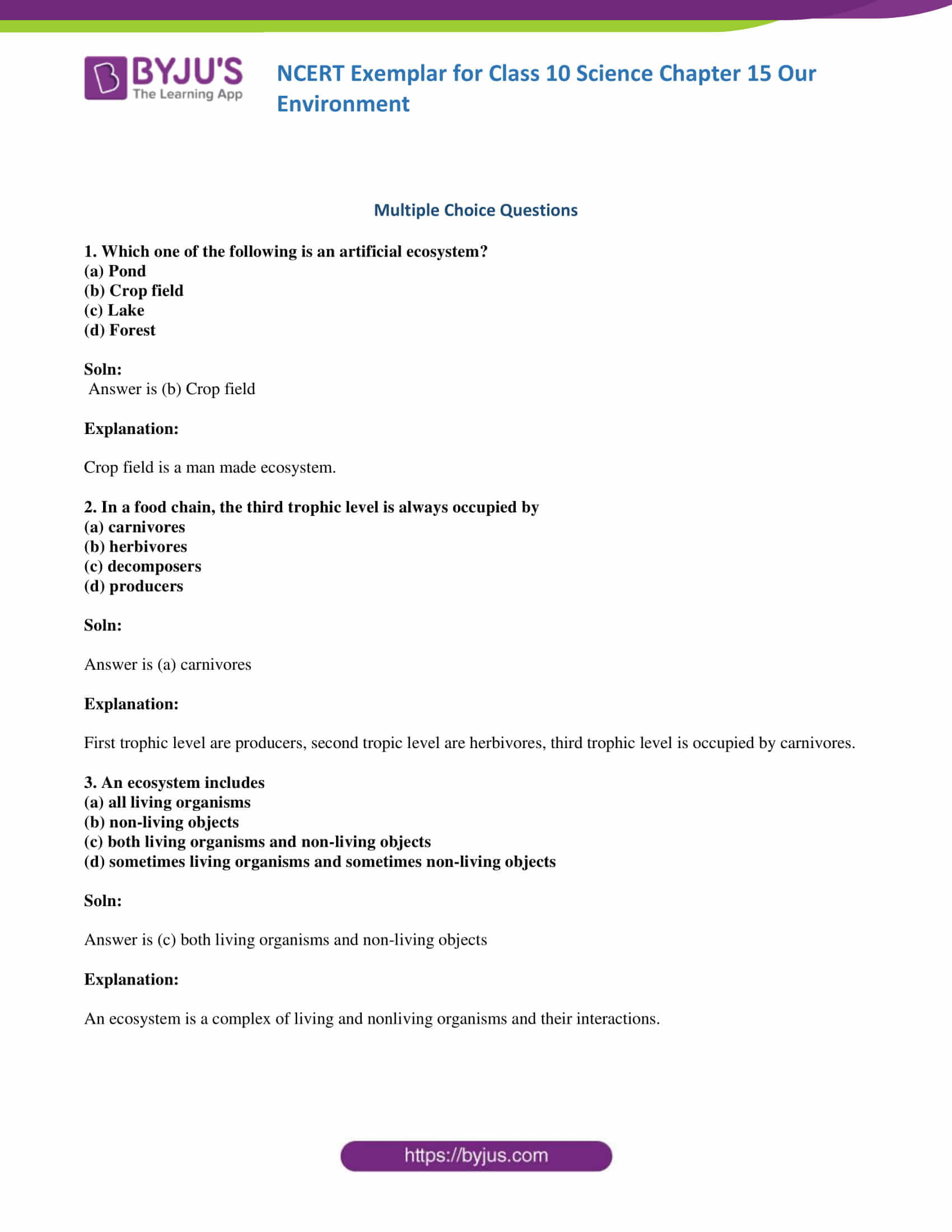
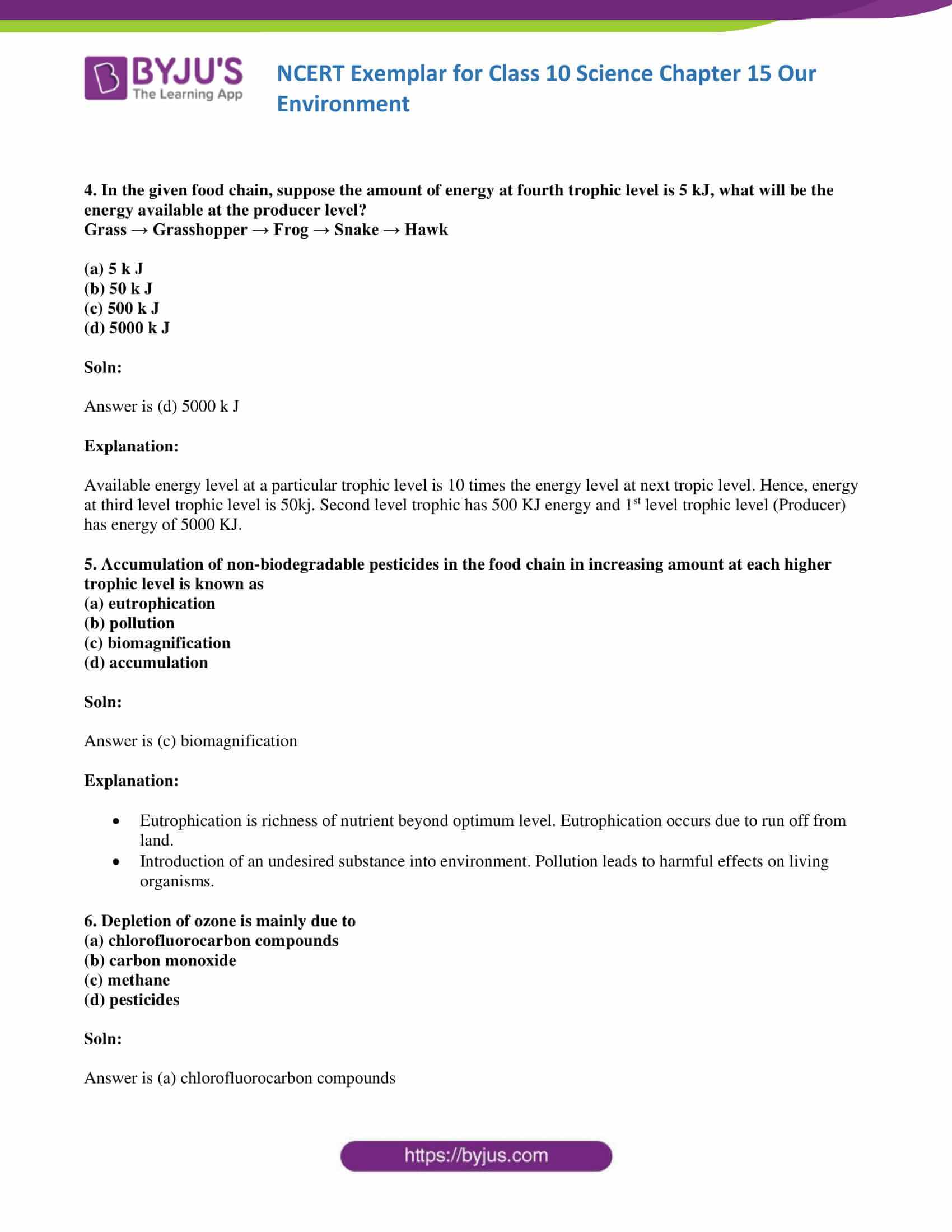


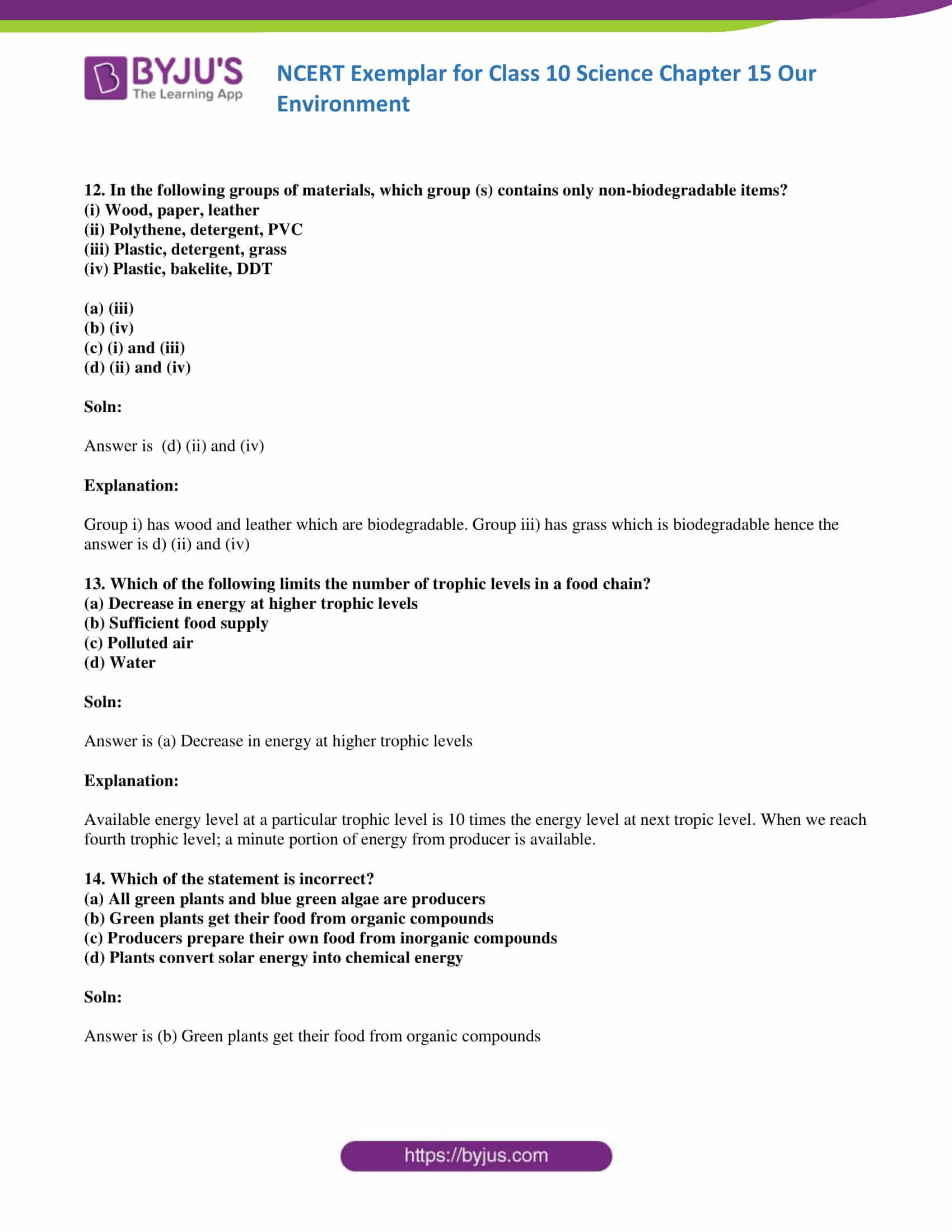
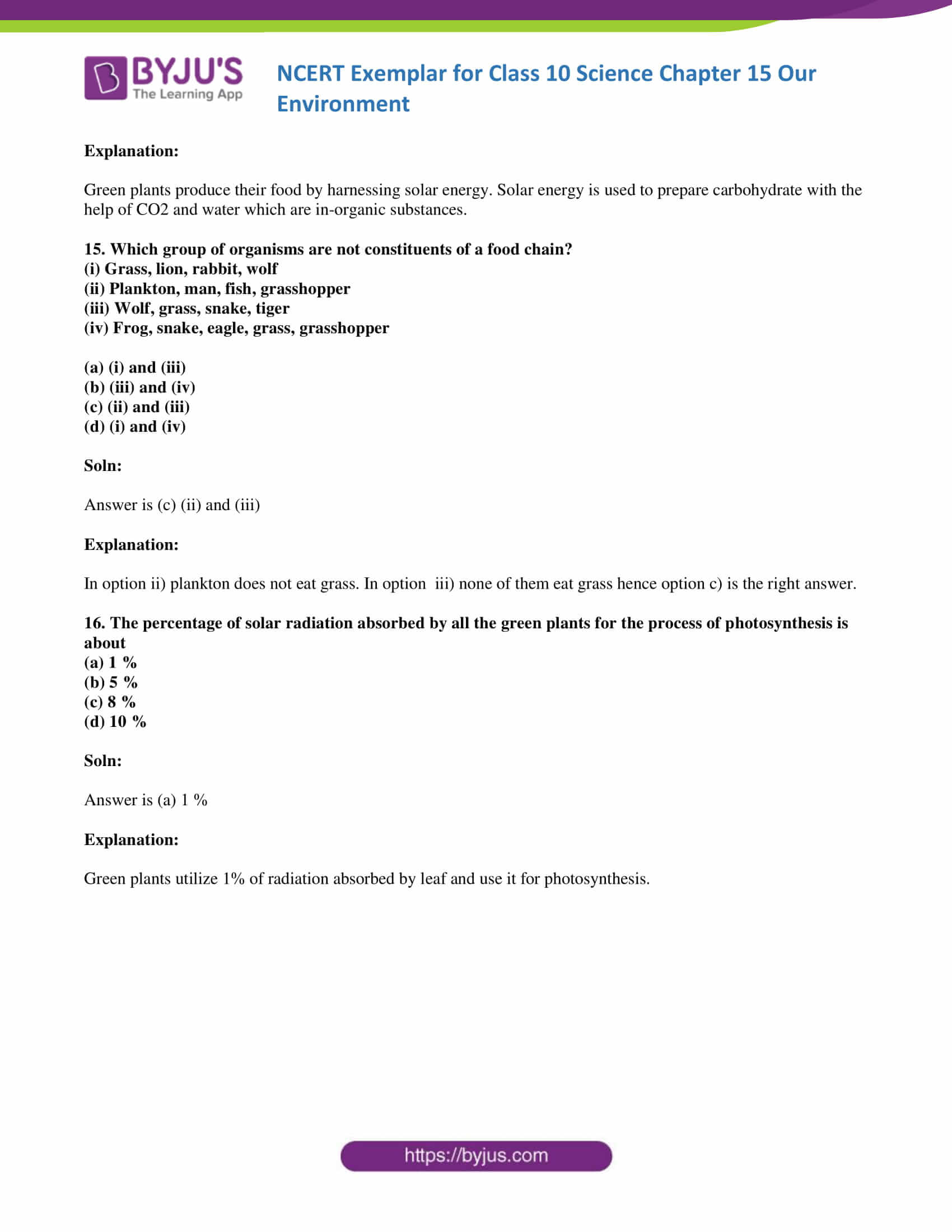
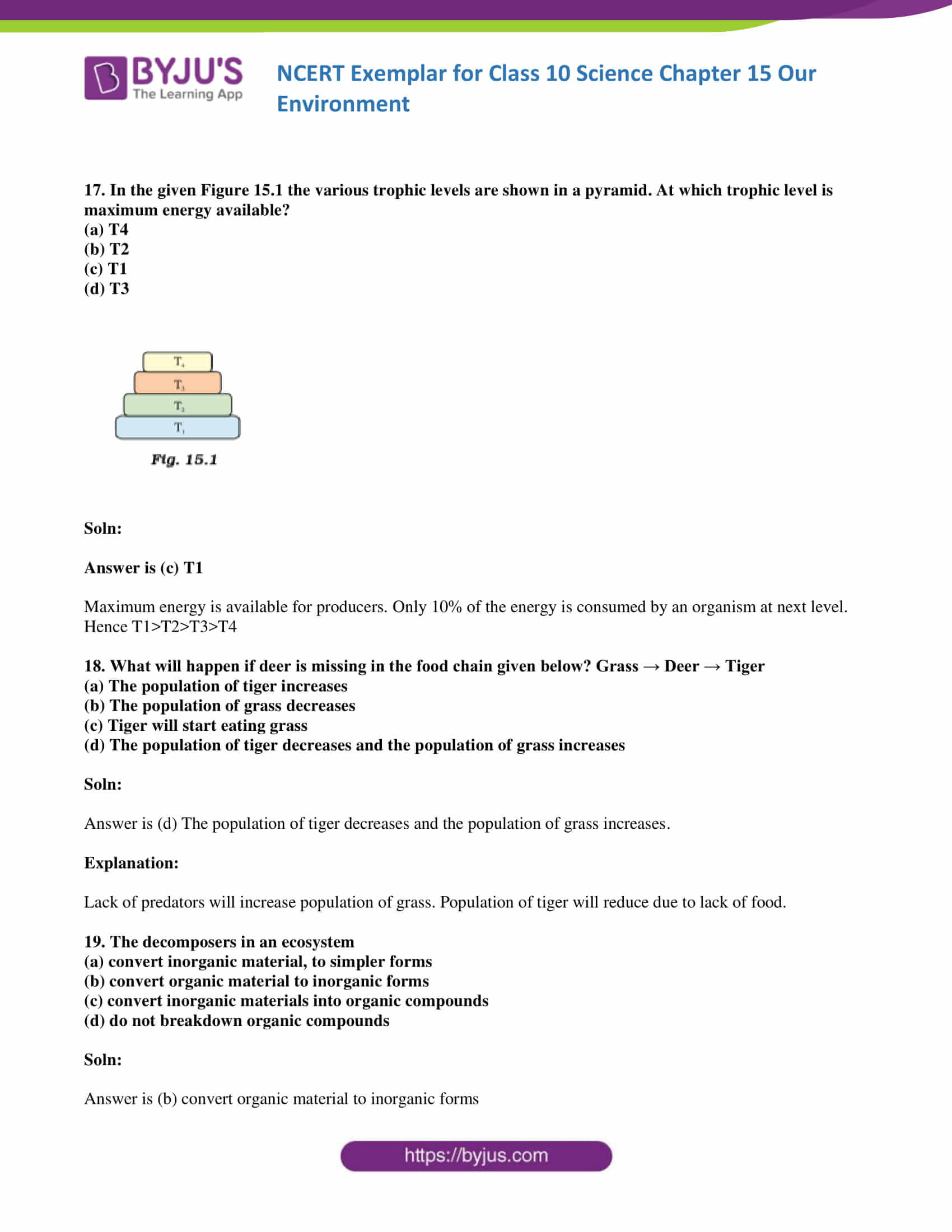
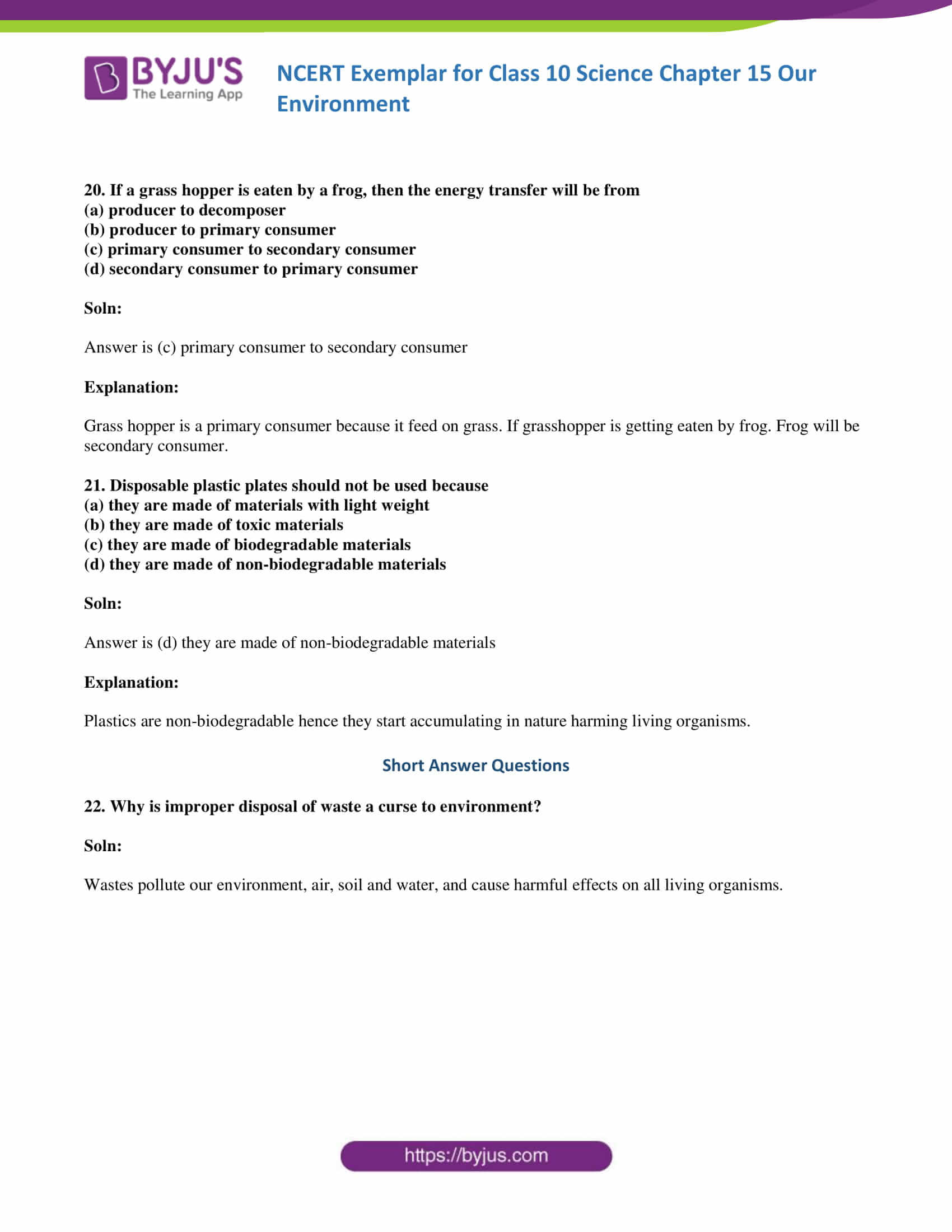
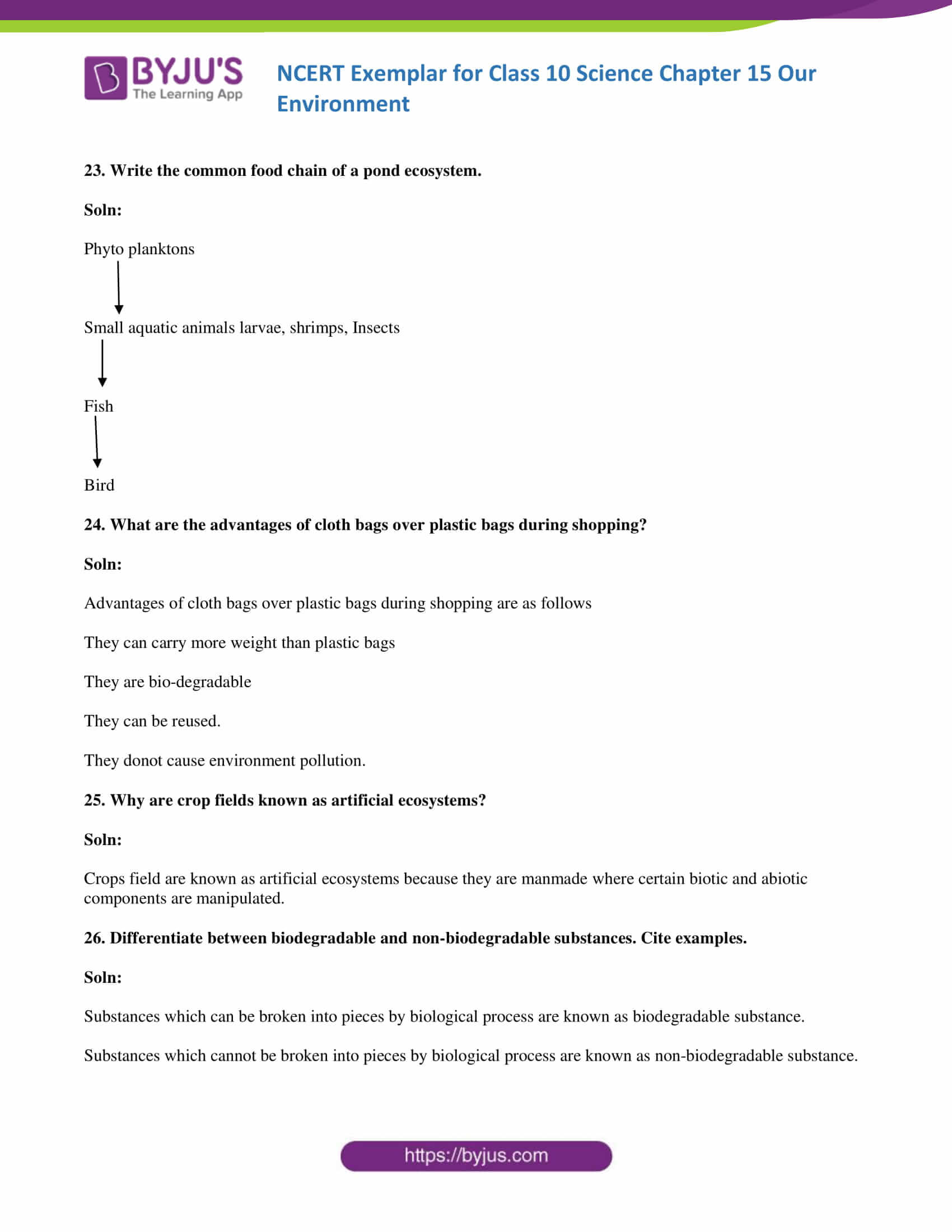
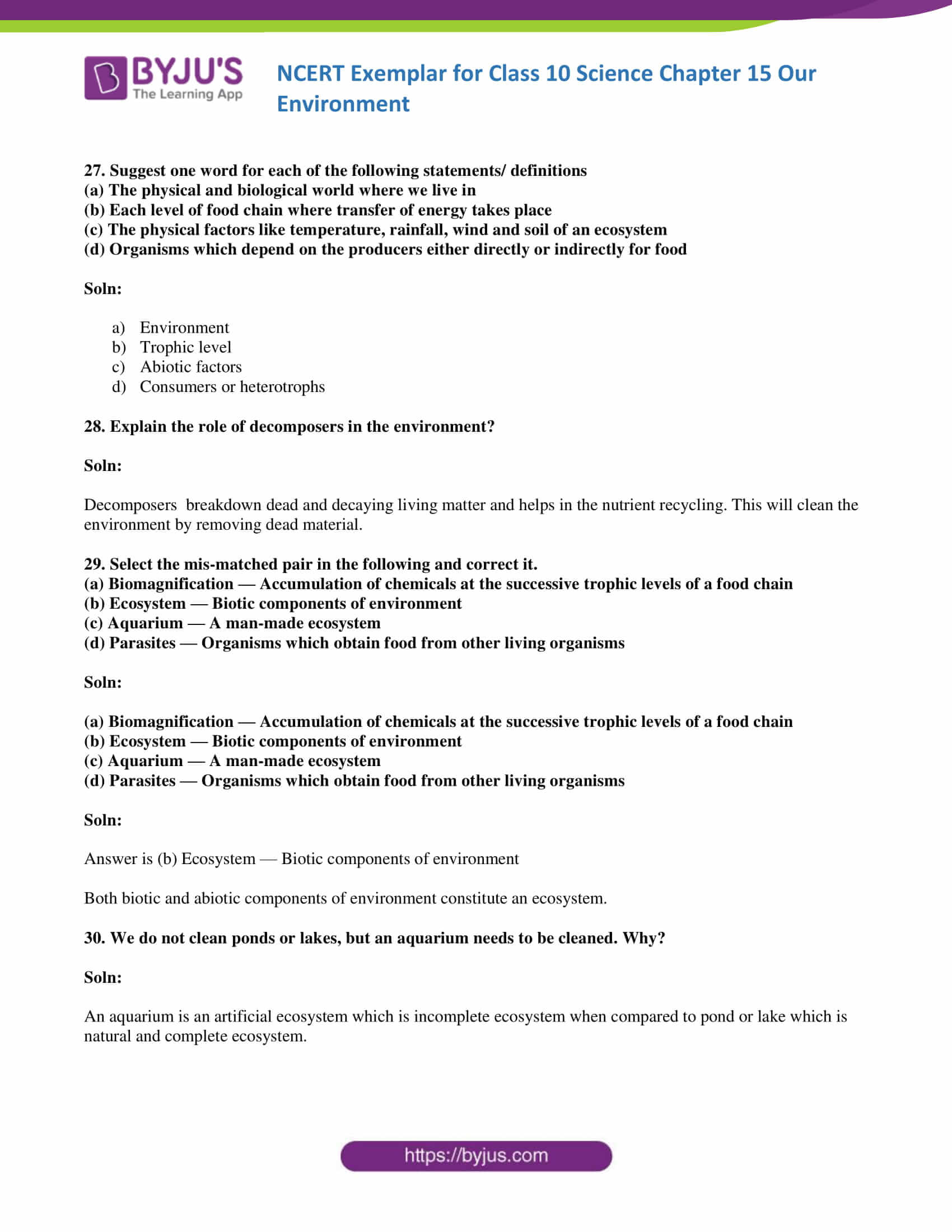
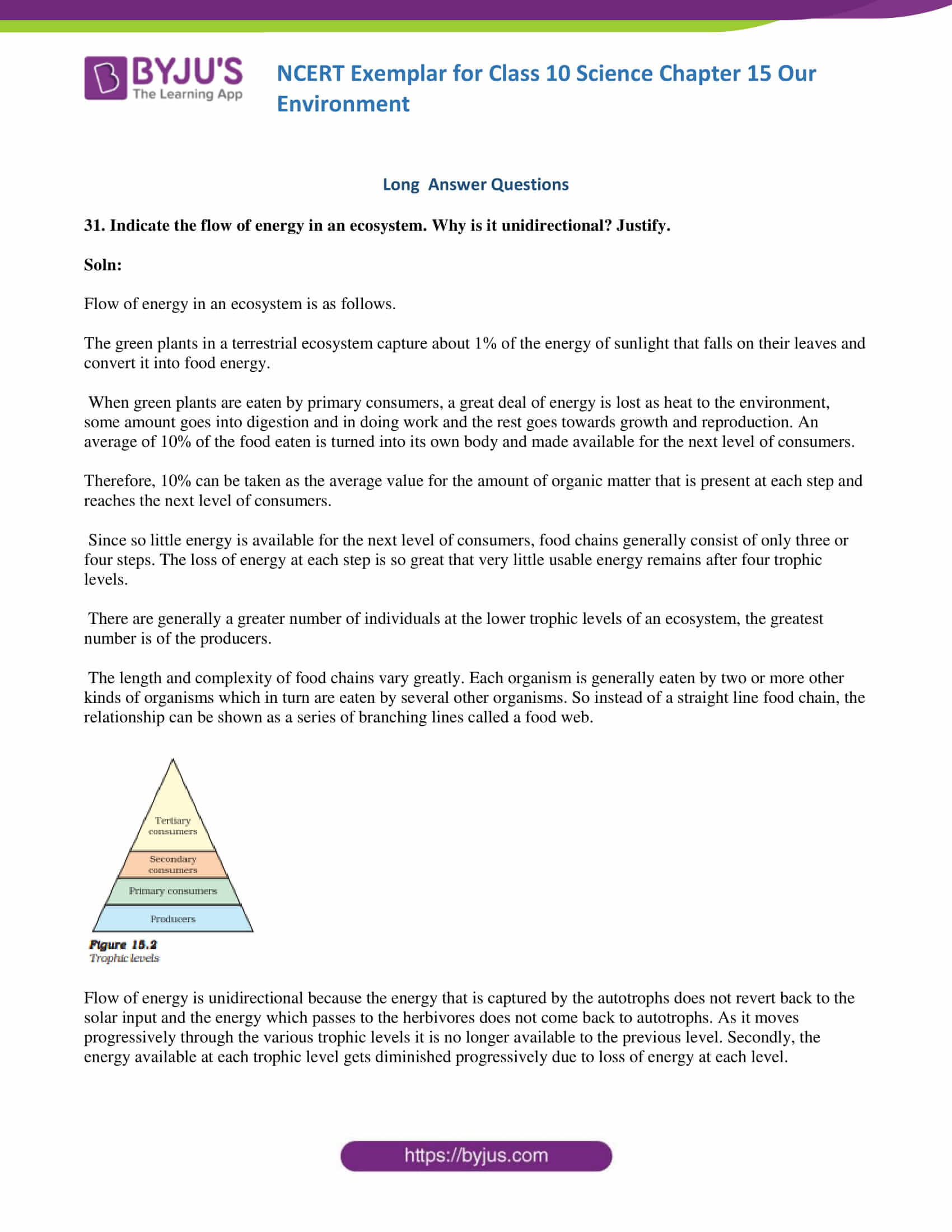
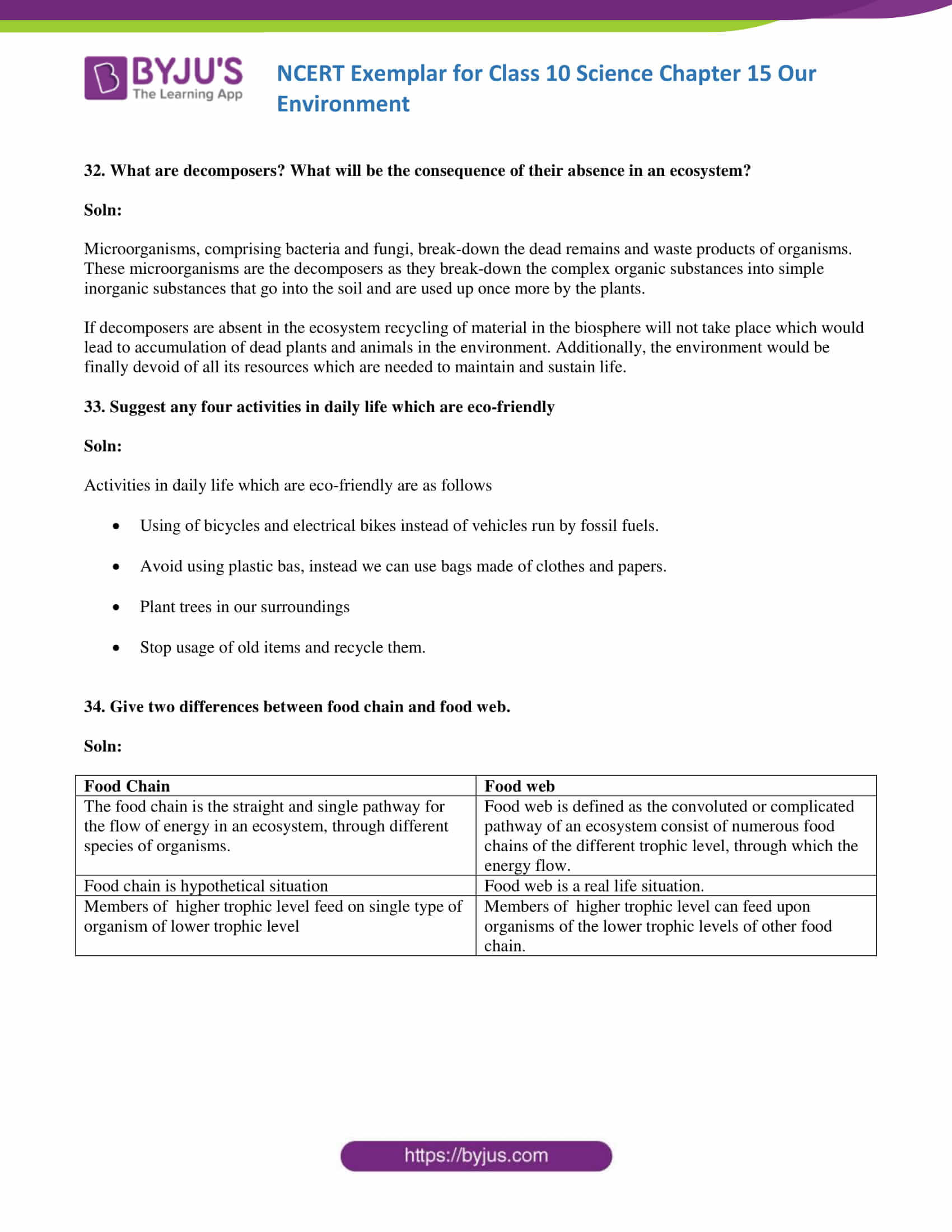
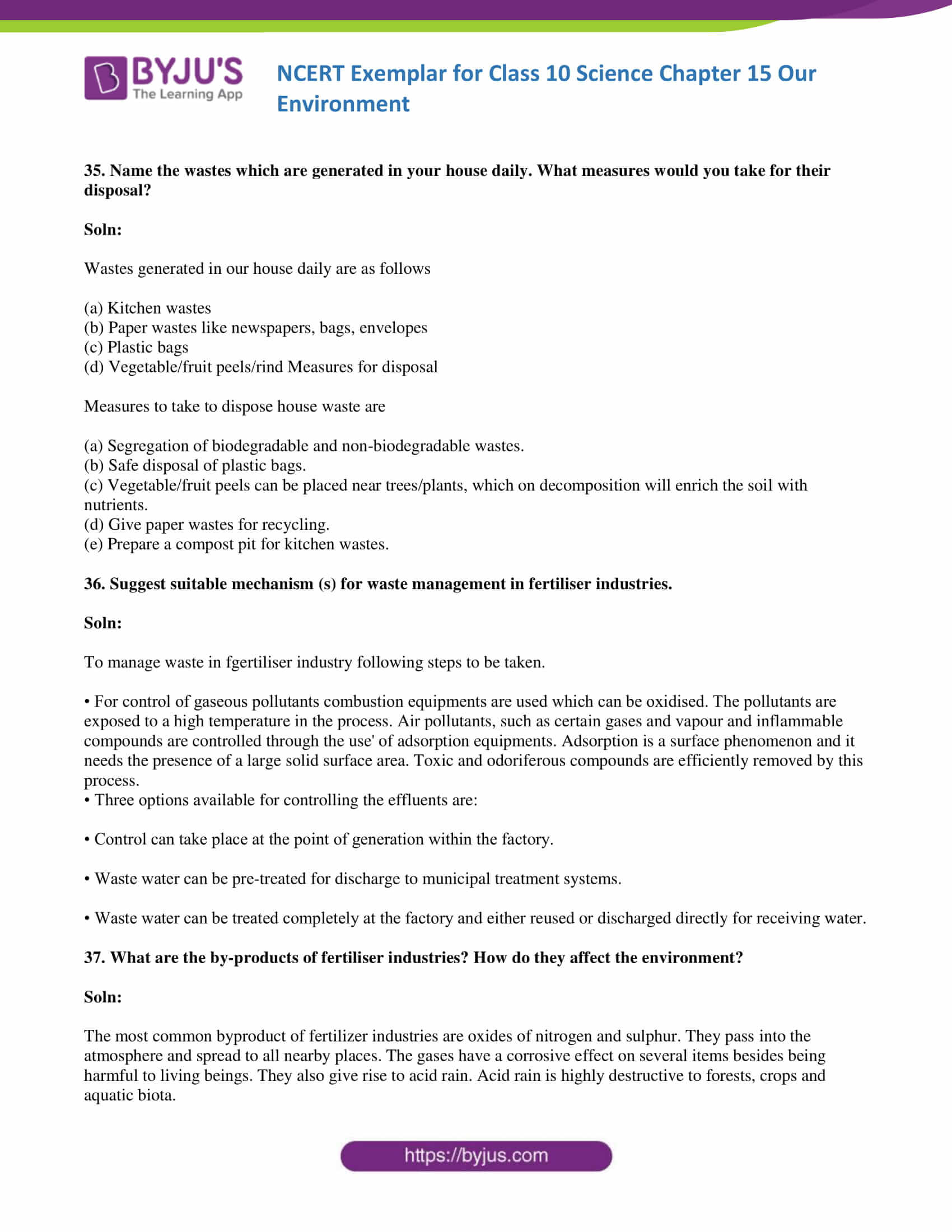
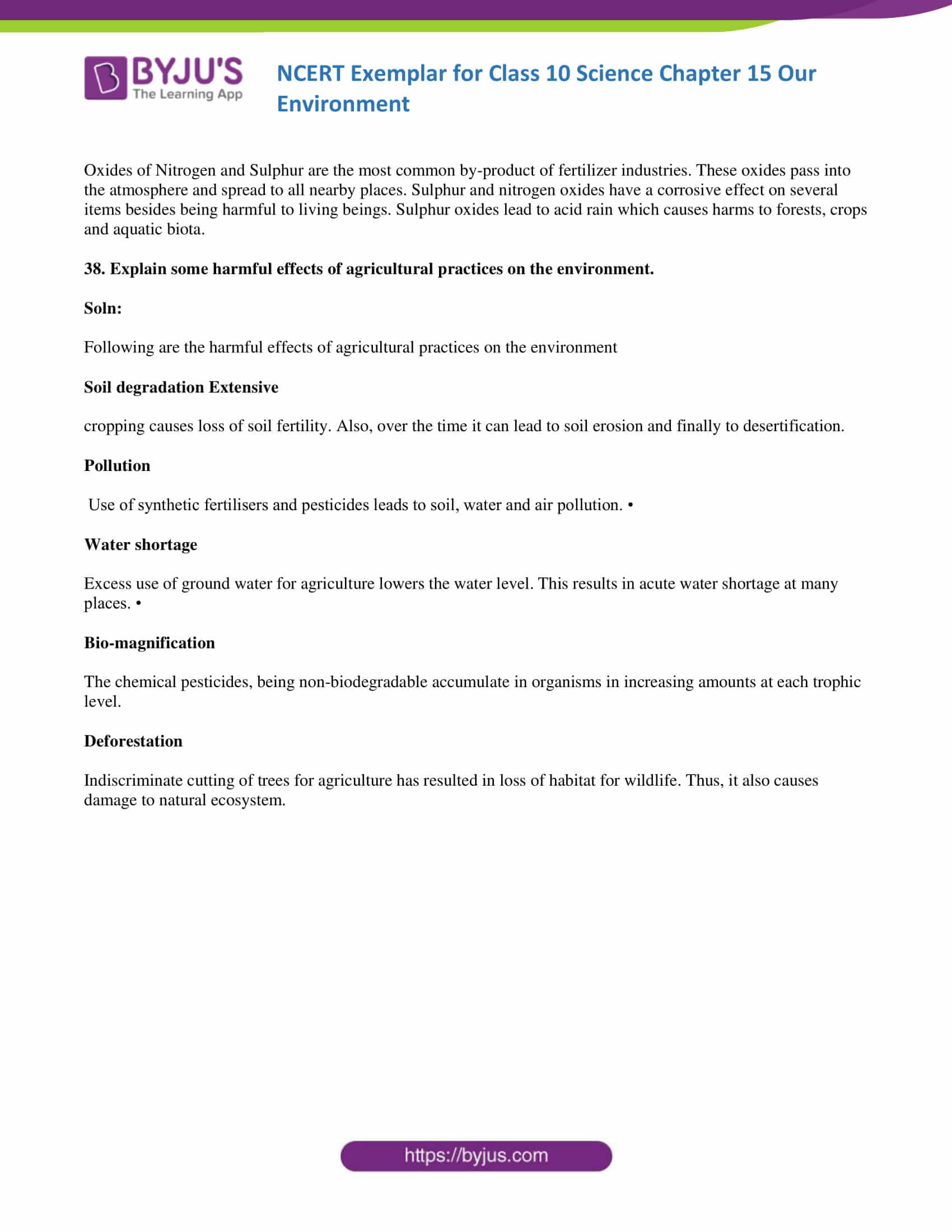
Comments